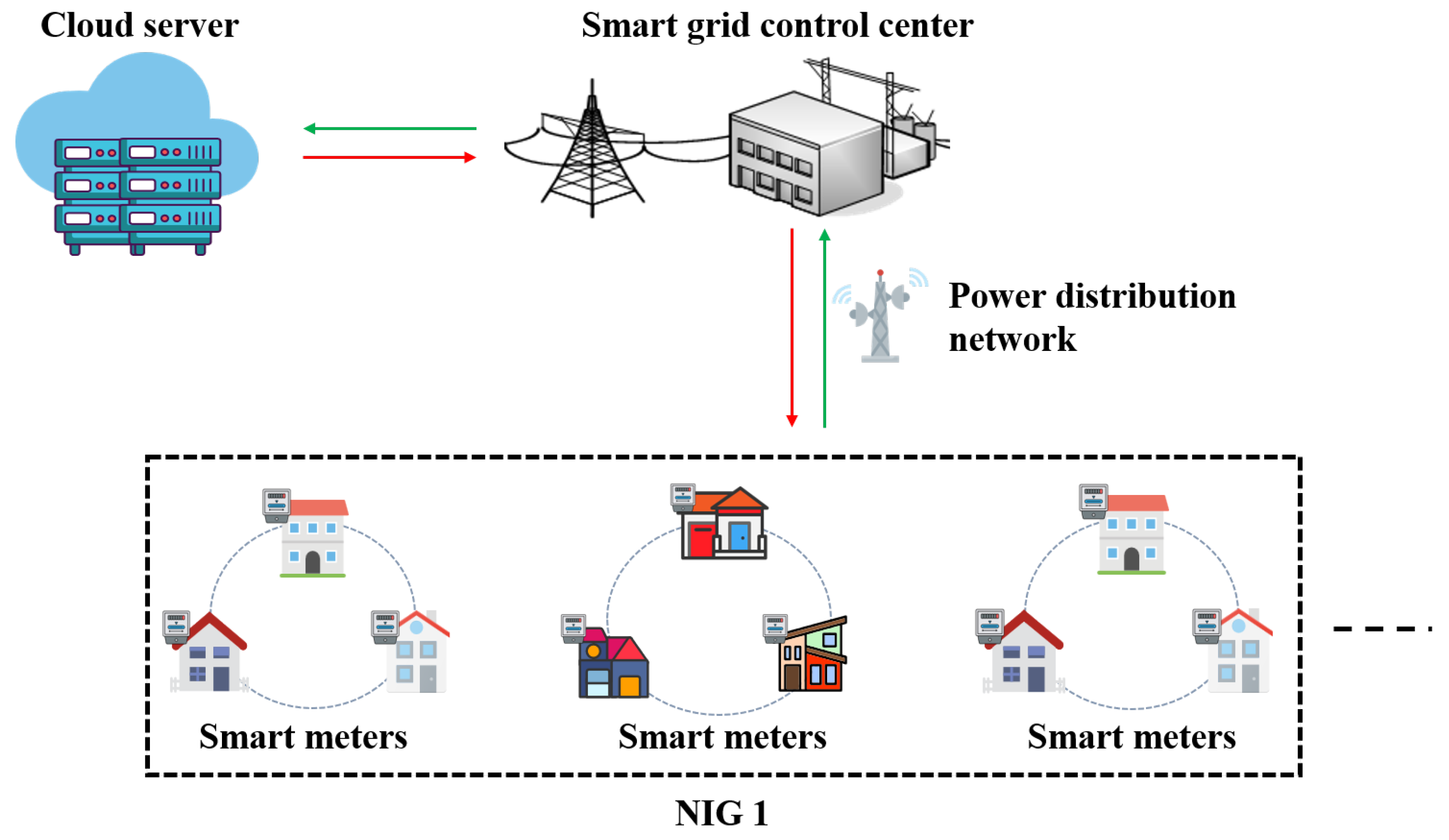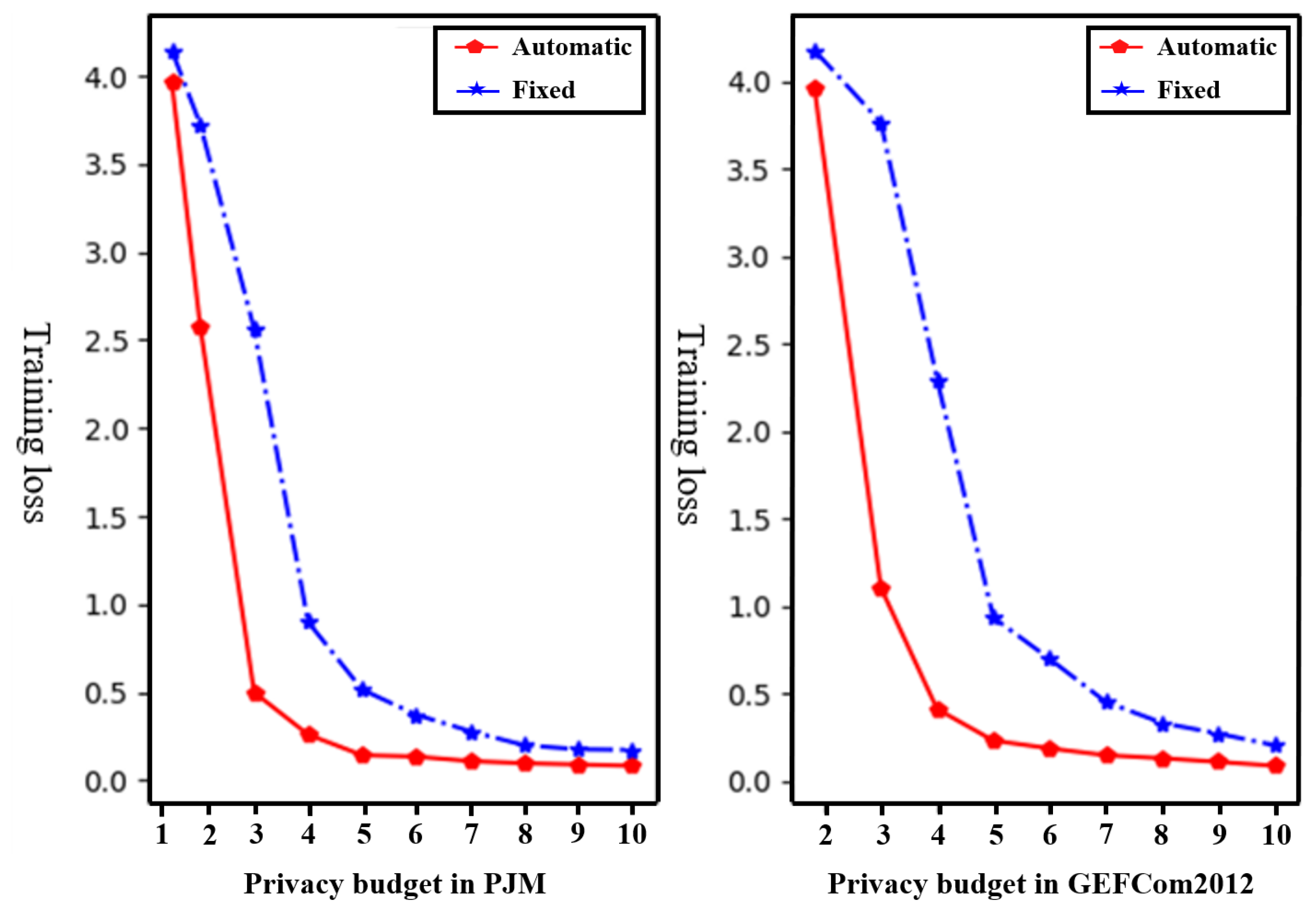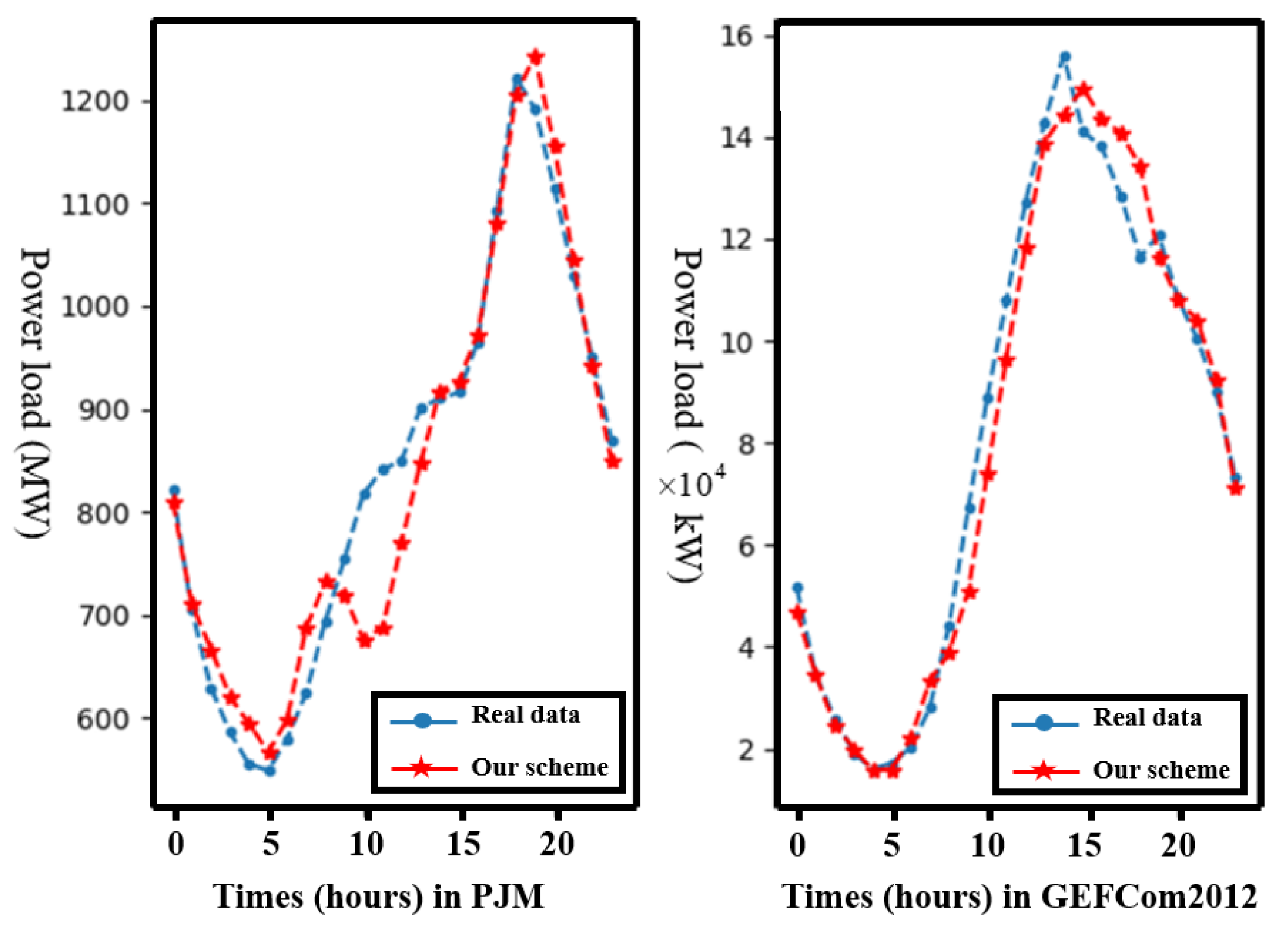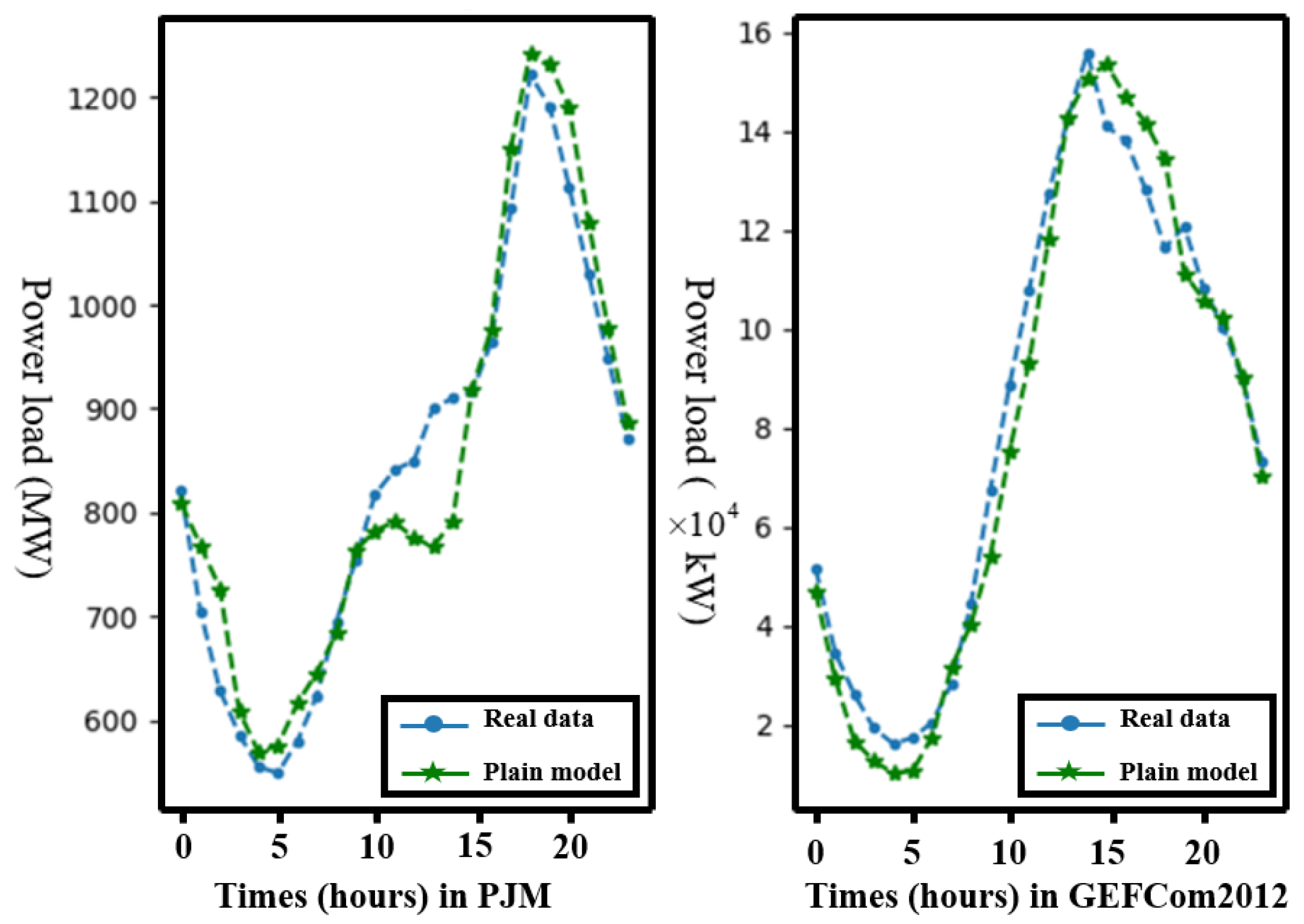Regional Load Forecasting Scheme for Security Outsourcing Computation
Abstract
1. Introduction
- In the context of smart grids, this paper introduces an outsourced model secure-training protocol alongside a secure online prediction protocol. Both protocols seamlessly integrate a range of privacy preservation techniques while optimizing computational performance in a balanced manner. Specifically, during the backpropagation phase of the training protocol, the differential privacy algorithm is employed to safeguard gradients, thereby circumventing the need for time-intensive homomorphic ciphertext multiplication and enhancing overall efficiency.
- The secure outsourced computing scheme presented in this paper necessitates the participation of merely one cloud server in protocol interactions. It confines the computational process to just the data holder and a solitary outsourced computing entity, thereby mitigating the overhead arising from interactions among multiple, non-colluding servers. This optimization renders the scheme significantly more practical for real-world implementations.
2. Related Work
3. System Model
- Cloud Server (CS): A reputable cloud service provider’s cloud server possesses impressive computing, storage, and communication capabilities. This server is equipped to acquire deep learning models through online training and capture real-time power load variations through instantaneous online prediction. Consequently, smart grids can utilize these predictive outcomes for efficient power management and scheduling.
- Smart Grid Control Center (SGCC): The smart grid control center is responsible for formulating power scheduling strategies and scheduling power resources in the smart grid. It aggregates load data from different regions. In our system, the SGCC outsources computational tasks to specialized cloud service providers, utilizes models built by cloud service providers, and employs their load prediction services for outsourced load forecasting.
- Power Distribution (PD): The power distribution network is the infrastructure responsible for power distribution. It primarily bears two responsibilities: collecting power data from regional power grids and aggregating them to the SGCC and transmitting control commands from the SGCC to the smart grid.
- Neighborhood IoT Grid (NIG1, NIG2, …, NIGn): Smart grid household users are divided into multiple neighborhood IoT grids. The smart grid supplies power to each neighborhood IoT grid while being responsible for regulating the entire power system. Each neighborhood IoT grid will generate a large amount of regional power data, which will be uploaded and stored in the smart grid system.
4. Our Scheme
4.1. Smart Grid Security Outsourcing Model Training Protocol
4.1.1. System Initialization
4.1.2. Data Encryption
4.1.3. Forward Propagation
| Algorithm 1 Privacy-Preserving Forward Propagation Algorithm. |
|
4.1.4. Backward Propagation
4.2. Smart Grid Security Outsourcing Online Forecasting Protocol
| Algorithm 2 Privacy-Preserving Backpropagation Algorithm. |
Require: Forward propagation output u, encrypted true values y, learning rate
|
4.2.1. Encryption Processing
4.2.2. Server-Side Computing
4.2.3. Decryption Processing
5. Security Analysis
6. Experiments
6.1. Experiment Settings
6.1.1. DataSet
6.1.2. Experimental Environment
6.1.3. Neural Network Structure
6.2. Training Protocol Performance Analysis
6.2.1. Comparison with the Existing Scheme
6.2.2. Privacy Analysis
6.3. Predictive Protocol Performance Analysis
7. Conclusions
Author Contributions
Funding
Data Availability Statement
Conflicts of Interest
References
- Hu, C.; Liu, Z.; Li, R.; Hu, P.; Xiang, T.; Han, M. Smart contract assisted privacy-preserving data aggregation and management scheme for smart grid. IEEE Trans. Dependable Secur. Comput. 2024, 21, 2145–2161. [Google Scholar] [CrossRef]
- Song, E.Y.; FitzPatrick, G.J.; Lee, K.B.; Griffor, E. A methodology for modeling interoperability of smart sensors in smart grids. IEEE Trans. Smart Grid 2022, 13, 555–563. [Google Scholar] [CrossRef] [PubMed]
- Lei, J.; Wang, L.; Pei, Q.; Sun, W.; Lin, X.; Liu, X. Privgrid: Privacy-preserving individual load forecasting service for smart grid. IEEE Trans. Inf. Forensics Secur. 2024, 19, 6856–6870. [Google Scholar] [CrossRef]
- Wang, Y.; Chen, Q.; Sun, M.; Kang, C.; Xia, Q. An ensemble forecasting method for the aggregated load with subprofiles. IEEE Trans. Smart Grid 2018, 9, 3906–3908. [Google Scholar] [CrossRef]
- Liu, Z.; Hu, C.; Ruan, C.; Hu, P.; Han, M.; Yu, J. An enhanced authentication and key agreement protocol for smart grid communication. IEEE Internet Things J. 2024, 11, 22413–22428. [Google Scholar] [CrossRef]
- Kumar, J.; Saxena, D.; Singh, A.K.; Vasilakos, A.V. A quantum controlled-not neural network-based load forecast and management model for smart grid. IEEE Syst. J. 2023, 17, 5714–5725. [Google Scholar] [CrossRef]
- Dewangan, F.; Abdelaziz, A.Y.; Biswal, M. Load forecasting models in smart grid using smart meter information: A review. Energies 2023, 16, 1404. [Google Scholar] [CrossRef]
- Lakshmi, K.; Gupta, H.; Ranjan, J. Analysis of general data protection regulation compliance requirements and mobile banking application security challenges. In Proceedings of the 2020 8th International Conference on Reliability, Infocom Technologies and Optimization (Trends and Future Directions) (ICRITO), Noida, India, 4–5 June 2020; pp. 1028–1032. [Google Scholar]
- Xuan, Z.; Gao, X.; Li, K.; Wang, F.; Ge, X.; Hou, Y. Pv-load decoupling based demand response baseline load estimation approach for residential customer with distributed pv system. IEEE Trans. Ind. Appl. 2020, 56, 6128–6137. [Google Scholar] [CrossRef]
- Tong, X.; Kang, C.; Xia, Q. Smart metering load data compression based on load feature identification. IEEE Trans. Smart Grid 2016, 7, 2414–2422. [Google Scholar] [CrossRef]
- Han, X.; Li, Z.; Xiao, X.; Ju, P.; Shahidehpour, M. Privacy-preserving outsourced computation of collaborative operational decisions among microgrids in an active distribution network. IEEE Trans. Power Syst. 2024, 1–14. [Google Scholar] [CrossRef]
- Krannichfeldt, L.V.; Wang, Y.; Hug, G. Online ensemble learning for load forecasting. IEEE Trans. Power Syst. 2021, 36, 545–548. [Google Scholar] [CrossRef]
- Beojone, C.V.; Geroliminis, N. Relocation incentives for ride-sourcing drivers with path-oriented revenue forecasting based on a markov chain model. Transp. Res. Part C Emerg. Technol. 2023, 157, 104375. [Google Scholar] [CrossRef]
- Wang, J.; Ye, L.; Ding, X.; Dang, Y. A novel seasonal grey prediction model with time-lag and interactive effects for forecasting the photovoltaic power generation. Energy 2024, 304, 131939. [Google Scholar] [CrossRef]
- Hagan, M.T.; Behr, S.M. The time series approach to short-term load forecasting. IEEE Power Eng. Rev. 1987, 2, 785–791. [Google Scholar]
- Chakhchoukh, Y.; Panciatici, P.; Mili, L. Electric load forecasting based on statistical robust methods. IEEE Trans. Power Syst. 2011, 26, 982–991. [Google Scholar] [CrossRef]
- Stephen, B.; Tang, X.; Harvey, P.R.; Galloway, S.; Jennett, K.I. Incorporating practice theory in sub-profile models for short term aggregated residential load forecasting. IEEE Trans. Smart Grid 2017, 8, 1591–1598. [Google Scholar] [CrossRef]
- Munkhammar, J.; van der Meer, D.; Widén, J. Probabilistic forecasting of high-resolution clear-sky index time-series using a markov-chain mixture distribution model. Sol. Energy 2019, 184, 688–695. [Google Scholar] [CrossRef]
- Gao, F. Application of improved grey theory prediction model in medium-term load forecasting of distribution network. In Proceedings of the 2019 Seventh International Conference on Advanced Cloud and Big Data (CBD), Suzhou, China, 21–22 September 2019; pp. 151–155. [Google Scholar]
- Zhao, H.; Guo, S. An optimized grey model for annual power load forecasting. Energy 2016, 107, 272–286. [Google Scholar] [CrossRef]
- Potapov, V.; Khamitov, R.; Makarov, V.; Gritsay, A.; Tyunkov, D.; Chervenchuk, I. Short-term forecast of electricity load for llc omsk energy retail company using neural network. In Proceedings of the 2018 Dynamics of Systems, Mechanisms and Machines (Dynamics), Omsk, Russia, 13–15 November 2018. [Google Scholar]
- Pan, Y.; Zheng, J.; Yang, Y.; Zhu, R.; Zhou, C.; Shi, T. An electricity load forecasting approach combining dbn-based deep neural network and nar model for the integrated energy systems. In Proceedings of the 2019 IEEE International Conference on Big Data and Smart Computing (BigComp), Kyoto, Japan, 27 February–2 March 2019. [Google Scholar]
- Ryu, S.; Noh, J.; Kim, H. Deep neural network based demand side short term load forecasting. Energies 2017, 10, 3. [Google Scholar] [CrossRef]
- Singh, S.; Hussain, S.; Bazaz, M.A. Short term load forecasting using artificial neural network. In Proceedings of the 2017 Fourth International Conference on Image Information Processing (ICIIP), Shimla, India, 21–23 December 2017; pp. 159–163. [Google Scholar]
- Shi, H.; Xu, M.; Li, R. Deep learning for household load forecasting—a novel pooling deep rnn. IEEE Trans. Smart Grid 2018, 9, 5271–5280. [Google Scholar] [CrossRef]
- Ciechulski, T.; Osowski, S. High precision lstm model for short-time load forecasting in power systems. Energies 2021, 14, 2983. [Google Scholar] [CrossRef]
- Mughees, N.; Mohsin, S.A.; Mughees, A.; Mughees, A. Deep sequence to sequence bi-lstm neural networks for day-ahead peak load forecasting. Expert Syst. Appl. 2021, 175, 114844. [Google Scholar] [CrossRef]
- Huang, Z.; Lu, W.-J.; Hong, C.; Ding, J. Cheetah: Lean and fast secure two-party deep neural network inference. In Proceedings of the 31st USENIX Security Symposium (USENIX Security 22), Boston, MA, USA, 10–12 August 2022; pp. 809–826. [Google Scholar]
- Nandakumar, K.; Ratha, N.; Pankanti, S.; Halevi, S. Towards deep neural network training on encrypted data. In Proceedings of the 2019 IEEE/CVF Conference on Computer Vision and Pattern Recognition Workshops (CVPRW), Long Beach, CA, USA, 16–17 June 2019; pp. 40–48. [Google Scholar]
- Wagh, S.; Gupta, D.; Chandran, N. Securenn: Efficient and private neural network training. In Proceedings of the Privacy Enhancing Technologies Symposium (PETS 2019), Stockholm, Sweden, 16–20 July 2019. [Google Scholar]
- Abadi, M.; McMahan, H.B.; Chu, A.; Mironov, I.; Zhang, L.; Goodfellow, I.; Talwar, K. Deep learning with differential privacy. In Proceedings of the 2016 ACM SIGSAC Conference on Computer and Communications Security, Vienna, Austria, 24–28 October 2016; pp. 308–318. [Google Scholar]
- Soykan, E.U.; Bilgin, Z.; Ersoy, M.A.; Tomur, E. Differentially private deep learning for load forecasting on smart grid. In Proceedings of the 2019 IEEE Globecom Workshops (GC Wkshps), Waikoloa, HI, USA, 9–13 December 2019. [Google Scholar]
- Mohassel, P.; Rindal, P. Aby3: A mixed protocol framework for machine learning. In Proceedings of the 2018 ACM SIGSAC Conference on Computer and Communications Security, Toronto, ON, Canada, 15–19 October 2018; Association for Computing Machinery: New York, NY, USA, 2018; pp. 35–52. [Google Scholar]




| Pure-HE | SecureNN | |
|---|---|---|
| Server Count | 1 | 3 |
| Anti-Collusion | ✓ | ✓ |
| Activation Function | Table-Lookup | Table-Lookup |
| Technologies Used | HE | SS, HE, DP |
| Model | Dataset | Training Time (s) |
|---|---|---|
| Pure-HE | PJM | 7328.34 |
| SecureNN | PJM | 612.32 |
| Secure Outsourcing Training Scheme | PJM | 1811.02 |
| Pure-HE | GEFCom2012 | 36,091.72 |
| SecureNN | GEFCom2012 | 2613.98 |
| Secure Outsourcing Training Scheme | GEFCom2012 | 9668.91 |
| Privacy Level () | MAPE (%) | Utility (%) |
|---|---|---|
| No Noise | 2.03 | 100 |
| 2.46 | 99.52 | |
| 2.85 | 99.08 | |
| 3.15 | 98.91 | |
| 3.49 | 98.57 | |
| 3.83 | 98.19 | |
| 6.50 | 95.34 | |
| 15.91 | 86.39 |
| Dataset | Pure-HE (s) | ABY3 (s) | Proposed Secure Prediction Protocol (s) |
|---|---|---|---|
| PIM | 158.634 | 14.183 | 42.842 |
| GEFCom2012 | 147.627 | 13.091 | 40.915 |
Disclaimer/Publisher’s Note: The statements, opinions and data contained in all publications are solely those of the individual author(s) and contributor(s) and not of MDPI and/or the editor(s). MDPI and/or the editor(s) disclaim responsibility for any injury to people or property resulting from any ideas, methods, instructions or products referred to in the content. |
© 2024 by the authors. Licensee MDPI, Basel, Switzerland. This article is an open access article distributed under the terms and conditions of the Creative Commons Attribution (CC BY) license (https://creativecommons.org/licenses/by/4.0/).
Share and Cite
Chen, Q.; Zhao, R.; Li, B.; Liu, Z.; Zhuang, H.; Hu, C. Regional Load Forecasting Scheme for Security Outsourcing Computation. Electronics 2024, 13, 3712. https://doi.org/10.3390/electronics13183712
Chen Q, Zhao R, Li B, Liu Z, Zhuang H, Hu C. Regional Load Forecasting Scheme for Security Outsourcing Computation. Electronics. 2024; 13(18):3712. https://doi.org/10.3390/electronics13183712
Chicago/Turabian StyleChen, Qizhan, Ruifeng Zhao, Bin Li, Zewei Liu, Huijun Zhuang, and Chunqiang Hu. 2024. "Regional Load Forecasting Scheme for Security Outsourcing Computation" Electronics 13, no. 18: 3712. https://doi.org/10.3390/electronics13183712
APA StyleChen, Q., Zhao, R., Li, B., Liu, Z., Zhuang, H., & Hu, C. (2024). Regional Load Forecasting Scheme for Security Outsourcing Computation. Electronics, 13(18), 3712. https://doi.org/10.3390/electronics13183712






